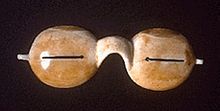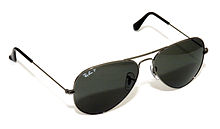A GLIMPSE OF SUN GLASSES>
HISTORY:-
Sunglasses or sun glasses are a form of protective eyewear designed primarily to prevent bright sunlight and high-energy visible light from damaging or discomforting the eyes. They can sometimes also function as a visual aid, as variously termed spectacles or glasses exist, featuring lenses that are colored, polarized or darkened. In the early 20th century they were also known as sun cheaters.
HISTORY:-
Sunglasses or sun glasses are a form of protective eyewear designed primarily to prevent bright sunlight and high-energy visible light from damaging or discomforting the eyes. They can sometimes also function as a visual aid, as variously termed spectacles or glasses exist, featuring lenses that are colored, polarized or darkened. In the early 20th century they were also known as sun cheaters.
Precursors
In prehistoric and historic time, Inuit peoples wore flattened walrus ivory "glasses," looking through narrow slits to block harmful reflected rays of the sun.
It is said that the Roman emperor Nero liked to watch gladiator fights with emeralds. These, however, appear to have worked rather like mirrors. Sunglasses made from flat panes ofsmoky quartz, which offered no corrective powers but did protect the eyes from glare were used in China in the 12th century or possibly earlier. Ancient documents describe the use of such crystal sunglasses by judges in ancient Chinese courts to conceal their facial expressions while questioning witnesses.
James Ayscough began experimenting with tinted lenses in spectacles in the mid-18th century, around 1752. These were not "sunglasses" as that term is now used; Ayscough believed blue- or green-tinted glass could correct for specific vision impairments. Protection from the Sun's rays was not a concern for him.
Yellow/amber and brown-tinted spectacles were also a commonly prescribed item for people with syphilis in the 19th and early 20th centuries because sensitivity to light was one of the symptoms of the disease.
Modern developments
In the early 1900s, the use of sunglasses started to become more widespread, especially among stars of movies. It is commonly believed that this was to avoid recognition by fans, but an alternative reason sometimes given is that they often had red eyes from the powerful arc lamps that were needed due to the extremely slow speed film stocks used. The stereotype persisted long after improvements in film quality and the introduction of ultraviolet filters had eliminated this problem. Inexpensive mass-produced sunglasses were introduced to America by Sam Foster in 1929. Foster found a ready market on the beaches of Atlantic City, New Jersey, where he began selling sunglasses under the name Foster Grant from a Woolworth on the Boardwalk.
Polarized sunglasses first became available in 1936, when Edwin H. Land began experimenting with making lenses with his patented Polaroid filter.
SOURCE : WIKI PEDIA.
Aviator sunglasses
Aviator sunglasses feature oversize teardrop-shaped lenses and a thin metal frame. The design was introduced in 1936 by Bausch & Lomb for issue to U.S. military aviators. As a fashion statement, aviator sunglasses are often made in mirrored, colored, and wrap-around styles.
In addition to pilots, Aviator-style sunglasses gained popularity with young people in the late
Clip-on glasses
Clip-on glasses are a form of tinted glasses that can be clipped on to eyeglasses for protection from the Sun. The best protection is polarized lens with 1.1mm. An alternative are flip-up glasses.
Oversized sunglasses
Oversized sunglasses, which were fashionable in the 1980s, are now often used for humorous purposes. They usually come in bright colors with colored lenses and can be purchased cheaply.
Shutter Shades
Shutter Shades were a fad in the early 1980s. Instead of tinted lenses, they decrease sun exposure by means of a set of parallel, horizontal shutters . Analogous to Inuit goggles , the principle is not to filter light, but to decrease the amount of sun rays falling into the wearer's eyes. To provide UV protection, Shutter Shades sometimes use lenses in addition to the shutters; if not, they provide very insufficient protection against ultraviolet radiation and blue light.
Teashades
"Teashades" were a type of psychedelic art wire-rim sunglasses that were often worn, usually for purely aesthetic reasons, by members of the 1960s counterculture, as well as by opponents of segregation. Pop icons such asMick Jagger, Roger Daltrey, John Lennon, Jerry Garcia, Boy George, Liam Gallagher,Charlie Bronson, and Ozzy Osbourne, all wore teashades. The original teashade design was made up of medium-sized, perfectly round lenses, supported by pads on the bridge of the nose and a thin wire frame. When teashades became popular in the late 1960s, they were often elaborated: Lenses were elaborately colored, mirrored, and produced in excessively large sizes, and with the wire earpieces exaggerated. A uniquely colored or darkened glasslens was usually preferred. Modern versions tend to have plastic lenses, as do many other sunglasses. Teashades are hard to find in shops today; however, they can still be found at many costume Web sites and in some countries.
Wayfarers
The Ray-Ban Wayfarer is a plastic-framed design for sunglasses produced by the Ray-Ban company. Introduced in 1952, the trapezoidal lenses are wider at the top than the bottom and were famously worn by James Dean, Roy Orbison and other actors and singers. The original frames were black; frames in many different colors were later introduced. There is always a silver piece on the corners as well.
Wrap-around sunglasses
Wrap-arounds are a specific design of sunglasses. They are characterized by a single, smooth, semi-circular lens that covers both eyes and much of the same area of the face covered by protective goggles. The lens is usually combined with a minimal plastic frame and single piece of plastic serving as a nosepiece. As an alternative, the glasses can have two lenses, but the design evokes the same semicircle.
Other names for sunglasses
There are various words referring to eyepieces with darkened lenses:
- Shades is probably the most widely used term for sunglasses in North America.
- Glares is a term popular in India if the glass is dark.
- Glints is a term for glasses originating from the "glint" that is noticeable when somebody wearing glasses moves their head.
- Sun spectacles is a term used by some opticians.
- Spekkies is a term used predominantly in southern Australia.
- Sun specs (also sunspecs) is the shortened form of sun spectacles.
- Sunglass a monocle version.
- Sun-shades can also refer to the sun-shading eyepiece-type, although the term is not exclusive to these. Also in use is the derivative abbreviation, shades.
- Dark glasses (also preceded by pair of) — generic term in common usage.
- Sunnies is Australian, South African, UK and New Zealand slang
- Smoked spectacles usually refers to the darkened eyepieces worn by blind people.
- Solar shields Usually refers to models of sunglasses with large lenses.
- Stunna shades Used as a slang term in the hyphy movement, usually referring to sunglasses with oversized lenses.
- Glecks is Scottish slang for glasses or sunglasses.
- Cooling glasses is a term used in Southern India (predominantly Kerala) and the Middle East for sunglasses.
NOTE : the information is truly taken from WIKI PEDIA WITH PERMISSION.









.jpg)


0 comments:
Post a Comment